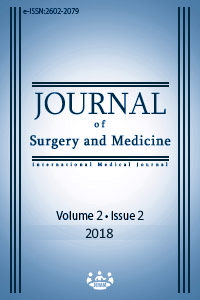Incidental gallbladder cancer: Review of 3856 cholecystectomies
Keywords:
Gallbladder, Incidental cancer, CholecystectomyAbstract
Aim: Gallbladder cancer (GBC) is a rare but fatal disease that causes more than 5000 new cases per year in the United States. In the pre-operative period, it is diagnosed in less than 20% of the cases of GBC. The remaining cases are diagnosed after laparoscopic cholecystectomy or intraoperative. Following the 0.25-3% of laparoscopic cholecystectomy, GBC is incidentally detected during histopathology. However, the incidental GBC constitutes 74-92% of all GBCs. The most important step in this disease is the correct staging. Staging determines disease management and treatment options and predicts survival. Curative surgeries in the treatment of GBC are limited to local resectable disease. In this study, it was aimed to present cases of GBC which was diagnosed incidentally after cholecystectomy and premalignant gallbladder lesions (BillIn: Biliary intraepithelial neoplasia).
Methods: 3856 patients who underwent cholecystectomy between 2009 and 2017 constituted the study universe. Patients who were diagnosed as incidental GBC (eight patients (0.21%)) and BillIn (five patients (0.12%)) were examined as a result of histopathological examination. The patients were recorded in terms of demographic data, histopathology, surgical reports and follow-up.
Results: A total of 13 (0.33%) patients were detected in the study group, including GBC and BillIn. The mean age of patients was 54.8±14.3 (age range 33-83), seven male and six women. Although cholecystectomy was performed more frequently in women (72.7%) as determined in the study universe, GBC was seen more frequently in male gender (p<0.05). Distribution of tumor stage in malignant patients was identified; four patients were observed in T2, three patients T1a and T3 GBC in one patient, BillIn in five patients.
Conclusion: GBC and BillIn are rare histopathological findings which are detected after cholecystectomy performed due to gallstone disease. Mean survival time of GBC is lower than other gastrointestinal cancers. The recent pre-operative examinations and a frozen-section examination in case of malignancy suspicion has been suggested in the literature, therefore surgeons should be prepared for advanced therapies.
Downloads
References
Jha V, Sharma P, Mandal KA. Incidental gallbladder carcinoma: Utility of histopathological evaluation of routine cholecystectomy specimens. South Asian J Cancer. 2018 Jan-Mar;7(1):21-23.
Aydın OU, Tihan ND, Sabuncuoğlu MZ, Dandin Ö, Yeğen FS, Balta AZ, et al. Assessment of lateral to medial dissection of Calot’s triangle in laparoscopic cholecystectomy: A case-control study. J Surg Med. 2018;2(1):27-31.
Zaidi MY, Maithel SK. Updates on Gallbladder Cancer Management. Curr Oncol Rep. 2018 Mar 2;20(2):21.
Shirai Y, Yoshida K, Tsukada K, Muto T. Inapparent carcinoma of the gallbladder. An appraisal of a radical second operation after simple cholecystectomy. Ann Surg. 1992;215:326-31.
Stoll M. Rationis medendi in nosocomio practico Vindobonensi. Pars prima; Sumtibus August Bernardi, Wien, 1977. p. 254.
Nevin JE, Moran TJ, Kay S, King R. Carcinoma of the gallbladder: staging, treatment and prognosis. Cancer. 1976;37:141-8.
Drouard F, Delamarre J, Capron JP. Cutaneous seeding of gallbladder cancer after laparoscopic cholecystectomy. N Engl J Med. 1991;325:1316.
Tatli F, Ozgönül A, Yucel Y, Yalcin HC, Ciftci R, Gümer M, et al. Incidental gallbladder cancer at cholecystectomy. Ann Ital Chir. 2017;6:399-402.
Egger B, Maurer CA, Bartels C, Baer HU. Primary carcinoma of the gallbladder. “A Swiss center’s experience”. Dig Surg. 1997;14:169-74.
Kondo S, Nimura Y, Kamiya J, Nagino M, Kanai M, Uesaka K, et al. Five-year survivors after aggressive surgery for stage IV gallbladder cancer. J Hepatobiliary Pancreat Surg. 2001;8:511-7.
Shih SP, Schulick RD, Cameron JL, Lillemoe KD, Pitt HA, Choti MA, et al. Gallbladder cancer: the role of laparoscopy and radical resection. Ann Surg. 2007;245:893-901.
Edge SB, Compton CC. AJCC cancer staging manual. 7th ed. New York: Springer, 2010;347-77.
Basak F, Hasbahceci M, Canbak T, Sisik A, Acar A, Yucel M, et al. Incidental Findings and Unexpected Cancers during Routine Pathologic Evaluation of Gallbladder Specimens: A Review of 1747 Elective Laparoscopic Cholecystectomy Cases. Ann R Coll Surg Engl. 2016 Apr;98(4):280-3.
Jemal A, Tiwari RC, Murray T, Ghafoor A, Samuels A, Ward E, et al. Cancer statistics, 2004. CA Cancer J Clin. 2004;54:8-29.
Marcial-Rojas RA, Medina R. Unsuspected carcinoma of the gallbladder in acute and chronic cholecystitis. Ann Surg. 1961;153:289-98.
Lundgren L, Muszynska C, Ros A, Persson G, Gimm O, Valter L, et al. Are Incidental Gallbladder Cancers Missed with a Selective Approach of Gallbladder Histology at Cholecystectomy? World J Surg. 2018 Apr;42(4):1092-9.
Scott TE, Carroll M, Cogliano FD, Smith BF, Lamorte WW. A casecontrol assessment of risk factors for gallbladder carcinoma. Dig Dis Sci. 1999;44:1619-25.
Yasui K, Shimizu Y. Surgical treatment for metastatic malignancies. Anatomical resection of liver metastasis: indications and outcomes. Int J Clin Oncol. 2005;10:86-96.
Copher JC, Rogers JJ, Dalton ML. Trocar-site metastasis following laparoscopic cholecystectomy for unsuspected carcinoma of the gallbladder. Surg Endosc. 1995;9:348-50.
Genç V, Onur Kirimker E, Akyol C, Kocaay AF, Karabörk A, Tüzüner A, et al. Incidental gallbladder cancer diagnosed during or after laparoscopic cholecystectomy in members of the Turkish population with gallstone disease. Turk J Gastroenterol. 2011;22:513-16.
Downloads
- 2061 2220
Published
Issue
Section
How to Cite
License
Copyright (c) 2018 Kemal Tekeşin, Abdullah Şişik
This work is licensed under a Creative Commons Attribution-NonCommercial-NoDerivatives 4.0 International License.















